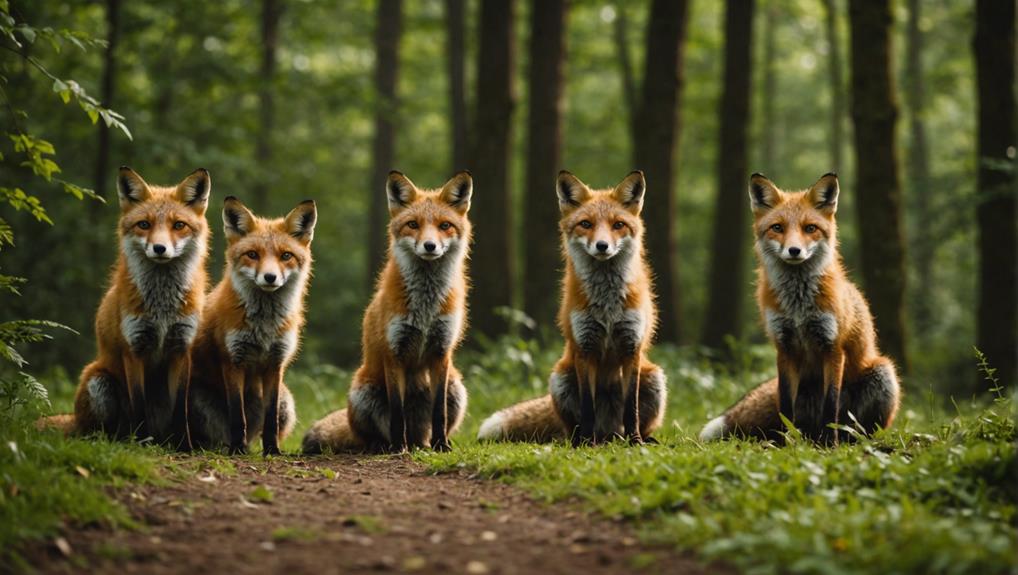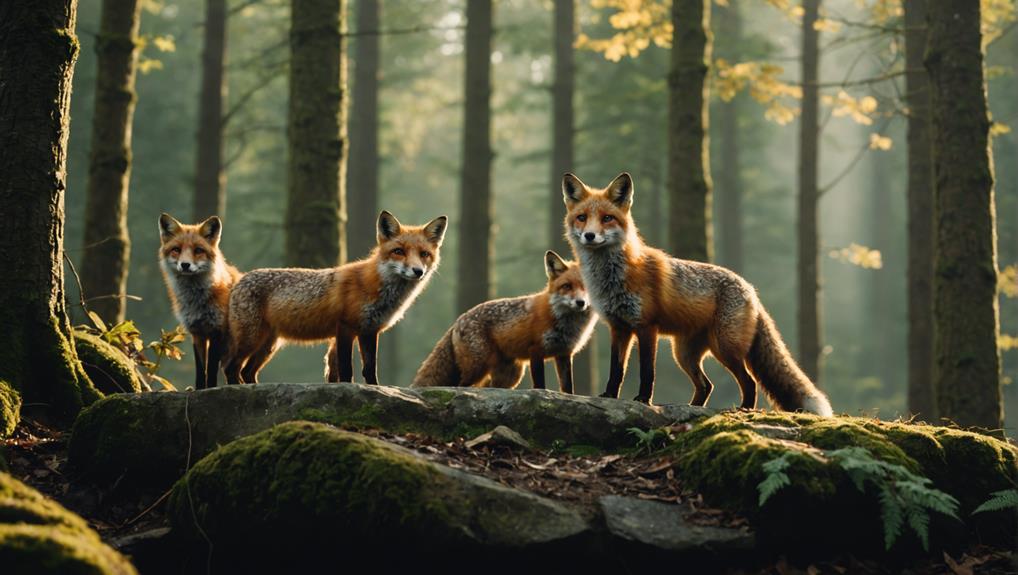Fox group dynamics are pretty intriguing! In a fox family, a dominant vixen takes charge, managing both territory and breeding rights, while subordinate foxes show respect through lowered heads and flat ears. Competition gets fierce, especially during mating season, and young cubs even engage in fights that can impact their survival. The dominant fox flaunts its authority with erect tails and upright ears, while social grooming helps keep everyone bonded. It's like a furry soap opera, but with survival stakes. Curious about how they navigate these relationships? Stick around to uncover more about their clever and cunning ways!
Contents
Canid Social Structure Overview
In understanding canid social structure, you'll find that foxes operate within a nuclear family system, where their social hierarchy is surprisingly fluid. Unlike what you might expect, these fox social groups adapt and change based on various factors, like the presence of new group members or shifts in resource availability. A dominant vixen usually leads the pack, managing territory and breeding opportunities, while subordinate foxes often show submission through lowered heads and flat ears.
This dynamic reflects their adaptability, which is essential for survival in diverse habitats, as highlighted in their unique habitat preferences.
Social grooming plays a key role here, too. It's not just about keeping fur clean; it strengthens bonds within the group. When grooming stops, you might notice increased isolation among individuals. This can lead to territorial disputes as foxes compete for resources, especially during the breeding season when tensions run high.
As cubs emerge, the competition begins early, sometimes as early as three weeks old! Size and strength dictate who gets to claim the top spot, with about 20% of cubs facing mortality during these scrappy early encounters.
Aggression and Competition Dynamics
Aggression and competition among foxes ramp up early, especially among cubs as young as three weeks old. You might be surprised to learn that these little ones begin establishing their social standing right away!
Size and strength often determine their place in the dominance hierarchy, and it can get fierce. Competitive interactions for food can lead to a staggering mortality rate of about 20% among cubs due to aggressive encounters, showcasing their resilience in urban environments. As urban foxes adapt to city life, their social dynamics reflect their need to navigate a landscape filled with both competition and cooperation the significance of social structures.
That's a tough world for them!
As they grow, adult foxes don't shy away from aggression either, particularly during mating season. You might witness body shoving and biting, with injuries often localized to the face and neck. To avoid serious fights, dominant cubs use a clever technique called body slamming to assert control over food resources.
It's like a friendly game of tag, but with a serious twist!
Interestingly, when new foxes join or leave a group, the entire hierarchy can shift, shaking up competition dynamics. So, whether they're vying for a tasty snack or a prime spot in the pack, aggression plays a significant role in their lives, shaping their future as they navigate this wild adventure together.
Communication Through Body Language

The intricate world of fox social dynamics doesn't just revolve around aggression; body language plays an essential role in their communication. When you observe a dominant fox, you'll notice its erect tail and upright ears, which signal authority. Notably, foxes like the Red Fox display these traits while adapting to various environments.
On the flip side, submissive foxes lower their heads and flatten their ears, clearly showing their place in the hierarchy.
Social grooming is another captivating aspect. It's like a spa day for foxes! This behavior strengthens bonds and helps confirm their social standing.
During disputes, aggressive postures, such as head-turning and body shoving, become significant non-verbal cues. They assert dominance without the need for a physical showdown.
Vocalizations, especially the quirky sound called "gekking," indicate heightened aggression and reveal a fox's emotional state. These sounds are often used during social interactions, adding another layer to their communication.
Play fighting among cubs is also essential. It's not just fun; these physical interactions help develop social skills and establish the pecking order before they leave the den.
Territoriality and Resource Management
How do foxes maintain their territories and manage resources? It's a fascinating dance of dominance, vocalizations, and body language. These clever creatures often face challenges when securing their territory.
Here are some key aspects of their territoriality:
- Dominant pairs: They primarily manage and defend their territory against intruders.
- Intrasexual aggression: Especially among vixens, this helps maintain status and secure resource access.
- Hierarchy: It's essential for reducing conflicts and establishing who gets what.
- Food scarcity: This can quickly spark territorial disputes and change dynamics within the group.
Foxes use vocalizations and body language to communicate conflicts, often opting for displays rather than physical fights. This approach minimizes injuries while still asserting dominance—smart foxes, right?
Territorial disputes can arise rapidly, especially when food is limited or population structures shift.
Reproductive Hierarchy and Control

Within the intricate dynamics of fox social structures, a clear reproductive hierarchy emerges, where only the dominant vixen breeds while subordinate females face exclusion from mating opportunities. It's like a royal court, where the dominant female calls the shots!
This means that these lower-ranking females often miss out on the chance to mate, which can feel unfair.
The dominant vixen manages to control breeding within her territory, often partnering with several males. This strategy boosts genetic diversity among her offspring, which is essential for a healthy population.
During mating season, male foxes roam far and wide, engaging in fierce competition to win over the vixen.
Litter sizes for foxes typically range from four to five cubs, but if conditions are right, those dominant breeding pairs can produce even bigger litters. Isn't that impressive?
Curiously, studies show that many urban fox litters have mixed paternity, with about one-third having multiple fathers. This challenges the idea of strict monogamy in their world.
Final Thoughts
In the world of foxes, understanding their group dynamics is like piecing together a puzzle—every behavior matters. From how they communicate to their strategies for survival, each element plays a crucial role in their social hierarchy. By appreciating their complex interactions, we can gain insight into the balance of nature. So, next time you see a fox, remember: there's more than meets the eye. They're not just cute; they're savvy social creatures steering their wild world!














